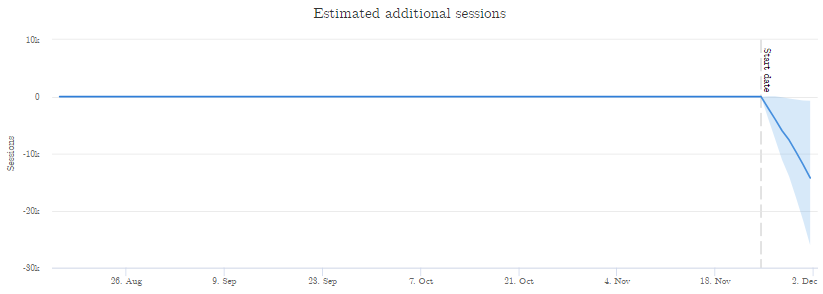Start here: how our SEO split tests work
If you aren't familiar with the fundamentals of how we run controlled SEO experiments that form the basis of all our case studies, then you might find it useful to start by reading the explanation at the end of this article before digesting the details of the case study below. If you'd like to get a new case study by email every two weeks, just enter your email address here.
This week, we asked our Twitter followers what they think happened to organic traffic when we added the price of a product to the title tag on an ecommerce client’s site.
This is what our followers thought:

Nearly 70% thought this had a positive impact.
In this case, the majority was incorrect.
This had a negative impact on organic traffic. Surprised? Read on for the full case study.
The Case Study
There are a lot of ways to make product pages stand out in the search engine results page (SERP) from rich snippets which may show rating stars, price, and availability, to leveraging titles and meta descriptions to give users valuable product info before clicking through.
While it’s exciting to win snazzy snippets, how does one know whether advertising the price from the SERP is actually the right thing to do?
Users are notoriously price sensitive, so having prices advertised right in the SERP that are even the slightest bit higher than the competition may mean bad news for click through rate.
Our case study this week puts this to the test by adding the price after the product name in the title tag on an ecommerce site. Below is an example of how this would look in a mock SERP.
| Control | Variant |
|---|---|
 |
 |
| Control |
|---|
 |
| Variant |
 |
The hypothesis behind this was that, given we were not displaying the price via a rich result like price snippets, advertising the price directly from the SERP by including it in the title would entice users to click through.
We were also aware that if competitors had lower advertised prices in their SERP snippets, this may deter users from clicking on our entry. Across thousands of product pages that we tested this on, we just didn’t know if that would be the case at scale; that’s where SearchPilot comes in.
Below is a chart showing what the impact was.

The resulting impact of this SEO split test was a 15% drop in organic traffic for the variant pages compared to their expected performance.
Pretty dramatic.
Why was this test negative?
While many competitors in this space do not display their prices in their titles, many do get the price displayed in a SERP snippet via their product schema. For example:

Our client, on the other hand, does not have the same price snippets. It’s possible users were deterred by how our price was displayed compared to competitors.
It’s also possible that the price itself relative to the competitive landscape caused us to look less appealing for some queries where competitors had cheaper prices, or none listed at all.
Another theory is that user experience may have been negatively impacted if users saw a different price listed in the title than what was on the page itself. This could have happened if the title was cached by Google at an inopportune time.
For this website, we saw conclusive evidence that adding prices to title tags was a bad idea for their organic traffic. This doesn’t mean it’s true for every site though - the SERP landscape, particular industries, and relative pricing between competitors could all impact how effective something like this would be. Stay tuned for future case studies with this change, where (spoiler alert!) you might see a different outcome.
How our SEO split tests work
The most important thing to know is that our case studies are based on controlled experiments with control and variant pages:
- By detecting changes in performance of the variant pages compared to the control, we know that the measured effect was not caused by seasonality, sitewide changes, Google algorithm updates, competitor changes, or any other external impact.
- The statistical analysis compares the actual outcome to a forecast, and comes with a confidence interval so we know how certain we are the effect is real.
- We measure the impact on organic traffic in order to capture changes to rankings and/or changes to clickthrough rate (more here).
Read more about how SEO A/B testing works or get a demo of the SearchPilot platform.
